Lenovo Legion Tower 5i review: mid-range to the max
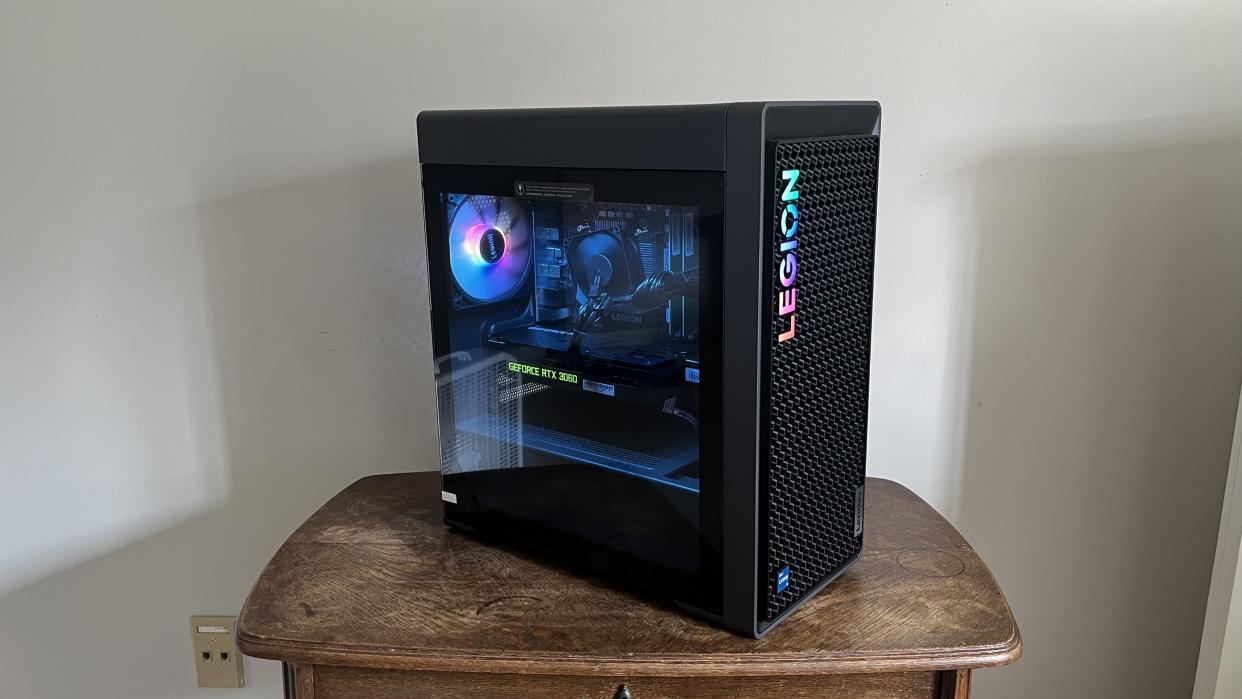
Lenovo Legion Tower 5i: One-minute review
The Lenovo Legion Tower 5i is quite a machine. It might not be some premium desktop that defies labels, but it’s a solid, good-looking desktop that does what it’s supposed to and does it quite well. On top of that, the price is pretty good.
Being a mid-range desktop, it does have a few flaws such as the limitations that are inherent in mid-range hardware. Well, and some bloatware that I’ll mention later on. But, you shouldn’t expect a computer equipped with an Nvidia GeForce RTX 3060 to handle ultra settings with ray tracing on.
That said, the total package is impressive enough that, for at least anyone looking for a good mid-range option, it might be one of the best gaming PCs available right now. While it doesn’t get cheap enough for those looking for budget gaming PCs, you should consider the Lenovo Legion Tower 5i if you can stretch your savings a little bit.
Lenovo Legion Tower 5i: Price & availability
How much does it cost? $1,249.99 (about £975, AU$21850)
When is it available? Available now
Where can you get it? Available in the US with limited configurations in UK
Almost all of the configurations of the Lenovo Legion Tower 5i come with an Nvidia GeForce RTX 3050, 3060, or 3060 Ti. Only the kitted-out version comes with a 4000 series GPU, specifically the Nvidia GeForce RTX 4070, which will set you back $2,099.99 / £2,150.00 (about AU$3114.88).
Interestingly, the base model that goes for $1,299.99 (about £975, AU$21850) is more expensive than the review unit, which seems to be a Best Buy exclusive. That means if you’re in the US, you can pay $1,249.99 / about £974.47 / about AU$21851.92 and save $50 while upgrading from an RTX 3050 to an RTX 3060 if you get the version from Best Buy.
To make matters more confusing, potential interested parties in the UK will be limited to more expensive builds with the RTX 4070 and those in Australia will only have access to the RTX 3050. Of course, we’re just discussing the configurations with Nvidia GPUs. If you prefer to go with Team Red, the Lenovo Legion Tower 5 (note the missing “i”) offer a whole set of configurations based around AMD, though we won’t dig into that in this review.
Looking beyond the various configurations, the Lenovo Legion Tower 5i is a solidly mid-range model in the company’s gaming desktop line. And, paying around $1,300 for great 1080p performance is, while not a bargain, pretty darn good. For comparison, the HP Victus 15L, which is a smaller, more stripped down PC (ie very limited RGB lighting) has very similar specs but goes for a higher $1,399.99 / £1,049.99 / about AU$2094.65.
Price score: 5 / 5
Lenovo Legion Tower 5i: Specs
The Lenovo Legion Tower 5i comes in a few different configurations, with the review unit being very similar to the base one. There's not a wide variation, with most coming with an Intel Core i5 and a mid-range Nvidia GeForce RTX 3000 series, with the kitted out version being the only one with a 4000 series GPU. The RAM is the same across all models, though the storage space is different from configuration to configuration.
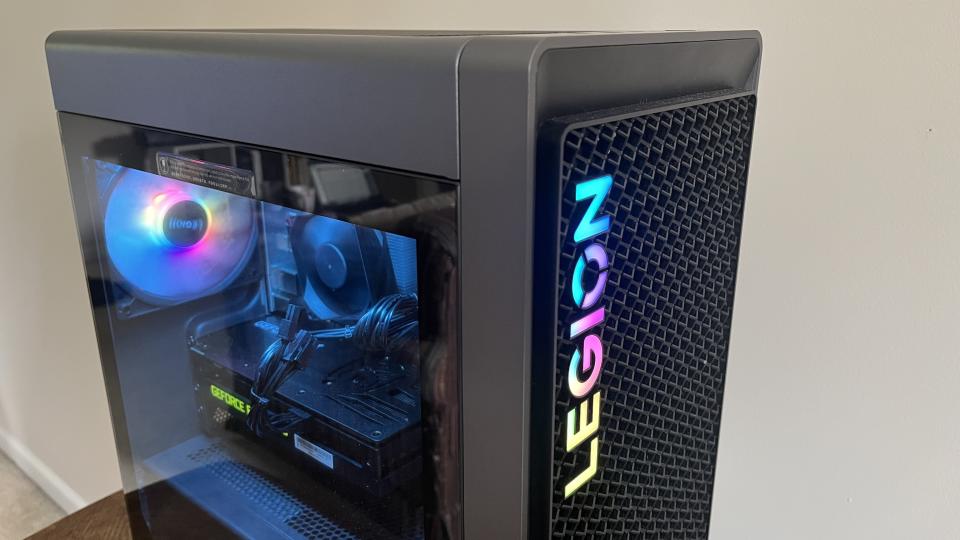
Lenovo Legion Tower 5i: Design
Has a nice elegant gamer look
Plenty of nice RGB lighting
Plenty of ventilation
Aesthetically, the Lenovo Legion Tower 5i strikes that elegant gamer look that, to my eyes, all Lenovo Legion products have. It’s a look I’ve always appreciated and that’s certainly the case here, especially since it’s on the larger side so is not the kind of computer you can discreetly place out of the way.
Part of its aesthetic is that almost matte-black color that Lenovo refers to as Storm Grey. But, part of it is the way Lenovo’s managed to give the case texture with its venting on the top and front without adding aggressive looking lines as you’ll find on many gamer-oriented products.
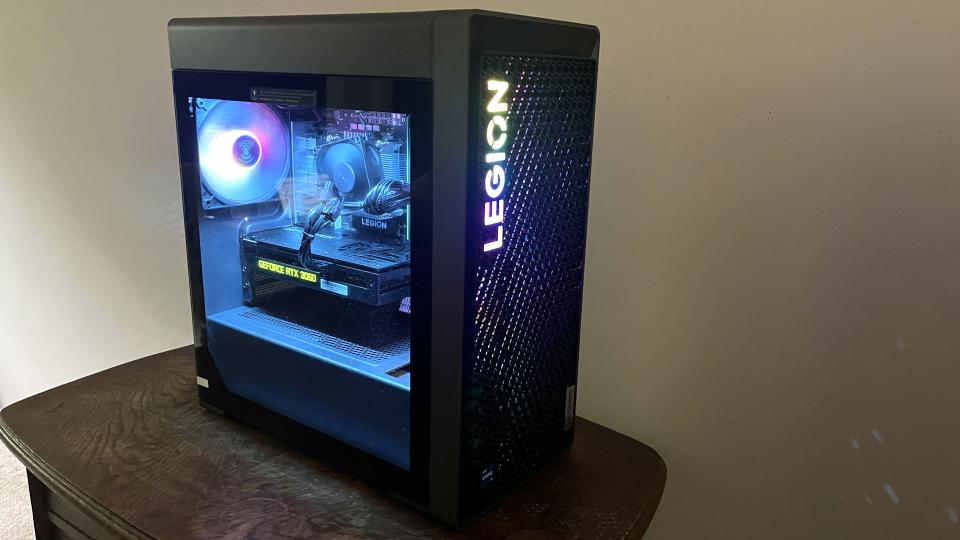

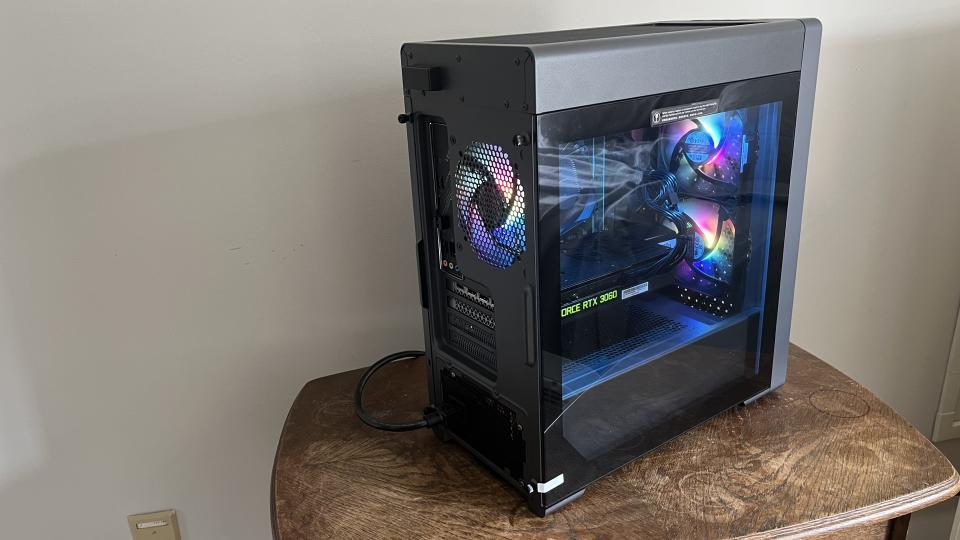
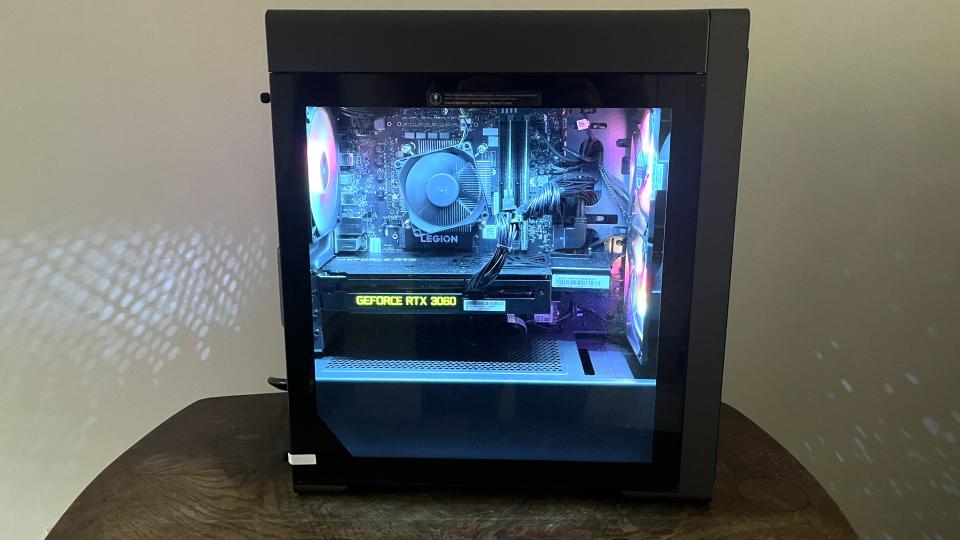
On top of that, the RGB lighting comes through in a few ways so that you get a nice light show instead of just one or two small zones of lighting. Not only is “LEGION” emblazoned down the front of the case, but the venting on the front allows for the cooling fans, which all sport RGB lighting, to shine through.
The glass side panel, which is held in place by two screws, allows for the lighting from the back cooling fan as well as the name on the graphics card to be easily seen. And, of course, that side panel lets you gaze and see the internals, which are cleanly installed.
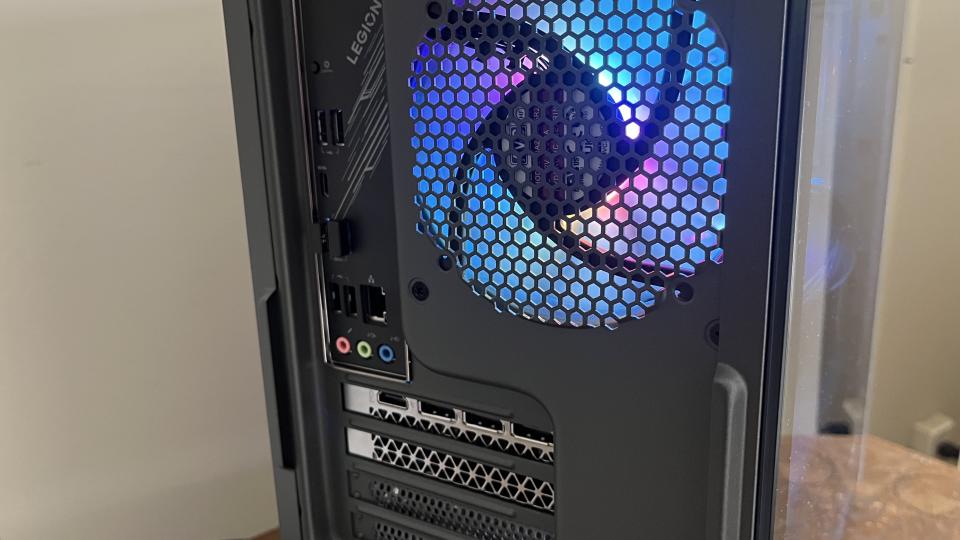
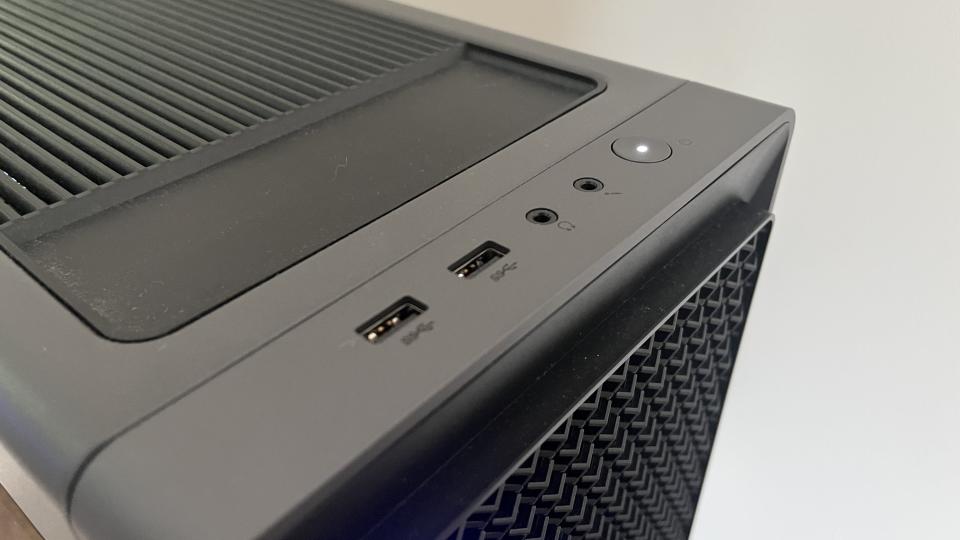
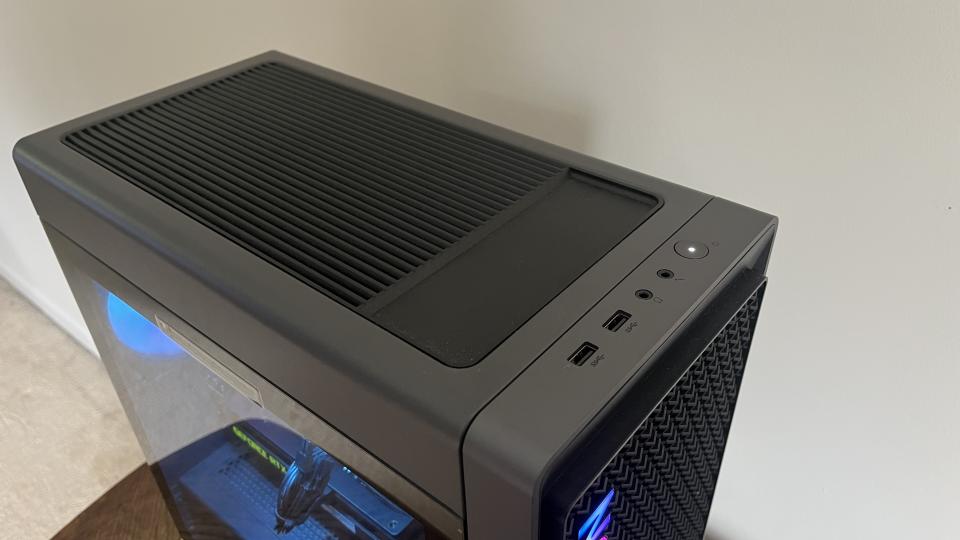
Speaking of the ventilation on this case, I never felt that there were any issues with a thermal bottleneck or potential overheating here. Along with the three cooling fans, not counting the one on the CPU, even pushing this computer hard didn’t concern me regarding internal temperatures.
When it comes to ports, there’s plenty on hand, though the selection is not quite what I would like. The top panel holds two USB ports as well as a headphone and mic jack, but there’s no USB-C. For that, you’ll have to go to the back where there are just two. On top of that, there’s no optical out, which I was hoping to use with a gaming soundbar.
Design score: 4.5 / 5
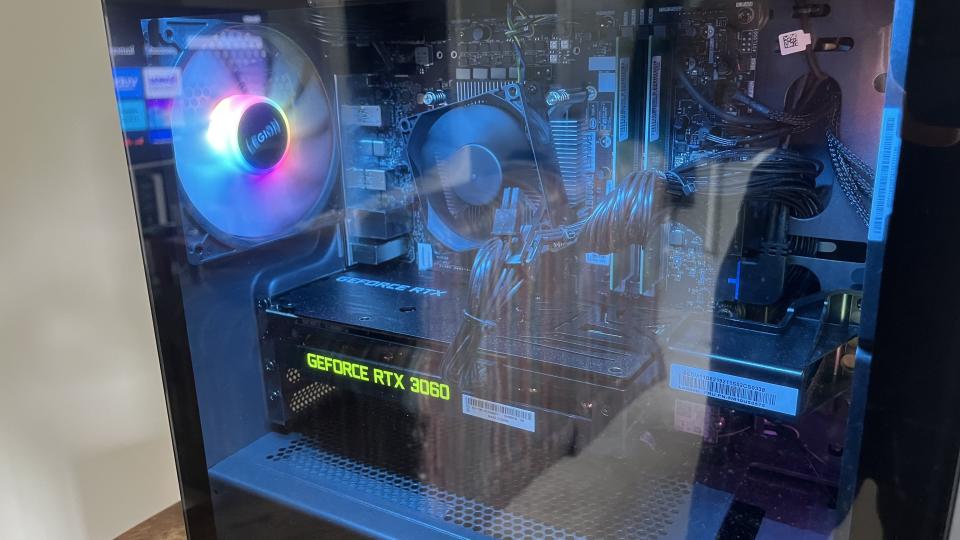
Lenovo Legion Tower 5i: Performance
Great 1080p performance for most games
Not powerful enough for ray tracing with high overall settings
Has some bloatware
Lenovo Legion Tower 5i: PC benchmarks
Here's how the Lenovo Legion Tower 5i performed in our suite of benchmark tests:
3DMark: Night Raid: 52,433; Fire Strike: 19,192; Time Spy: 8,992
GeekBench 5.5: 1673 (single-core); 11272 (multi-core)
CrossMark: Overall: 1754 Productivity: 1667 Creativity: 1899 Responsiveness: 1612
Total War: Warhammer III (1080p, Ultra): 74 fps; (1080p, Low): 204 fps
Cyberpunk 2077 (1080p, Ultra): 71.07 fps; (1080p, Low): 117.39 fps
Dirt 5 (1080p, Ultra): 82.6 fps; (1080p, Low): 193.7 fps
Handbrake 1.6: 5:35
Even though the Lenovo Legion Tower 5i reviewed is pretty close to the base configuration, it’s surprisingly powerful as long as you stay at 1080p. With a 13th-Gen Intel Core i5, 16GB of RAM, and an Nvidia GeForce RTX 3060, the 1080p performance is very strong.
Just look at our benchmarks. Cyberpunk 2077 hits over 70 fps on Ultra settings and that’s a fairly demanding title, even if it’s been out for a few years. Beyond the benchmarks, I ran Control, Far Cry 6 and Gotham Knights all at pretty high settings with great results. However, I still could see the limitations of the RTX 3060. I would get slight screen tearing in Control at max settings, while I had to stick with medium settings with Vsync on for Hogwarts Legacy to minimize screen tearing. And, even then I would get some stuttering.
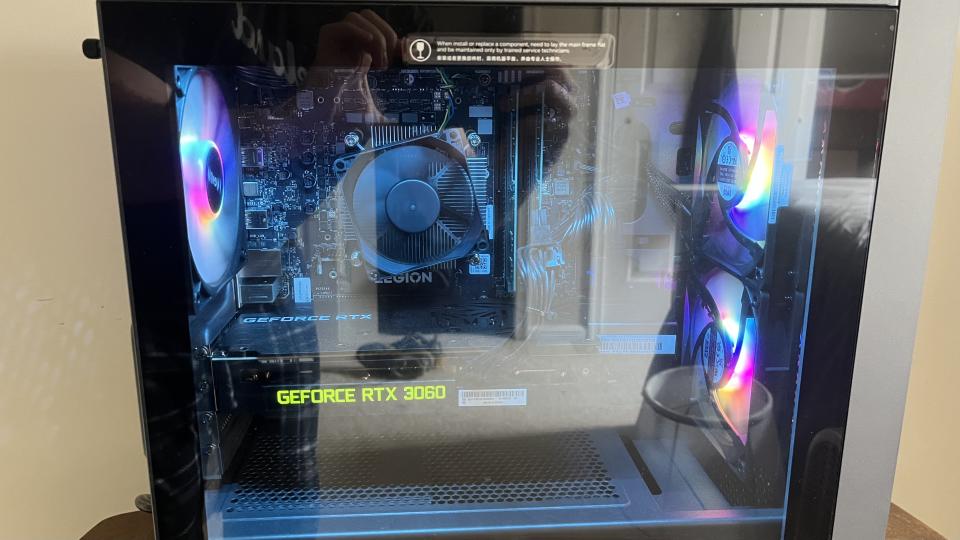
To that end, turning on ray tracing would negatively affect performance and I would get enough screen tearing to be very distracting. And, while I couldn’t test HDR with my current setup, you probably will have to adjust settings as well if you want to turn HDR on.
Using this PC in general is easy and straightforward as Lenovo has included some proprietary software that’s useful but limited, thankfully, to just a handful of apps. They do what you would expect from gaming computer apps like monitoring internal temperatures and doing slight overclocks or network boosts. And, as nice as the apps are, Lenovo has also included McAfee. If you use that brand of antivirus software, then this isn’t an issue. I don’t, however, and get bombarded regularly to activate my subscription. It’s a bit invasive. While it’s typical to get some extra software that requires a subscription, this one’s a bit much.
Performance score: 4 / 5
Should you buy the Lenovo Legion Tower 5i?
Buy it if...
You want a fantastic 1080p machine
While you’re limited by the hardware that you get, the Lenovo Legion Tower 5i squeezes every bit of performance out of its components for rock solid 1080p performance in most situations.
You want a good-looking gaming desktop
It’s not overly aggressive with its styling, but this desktop manages to look in a gamer kind of way while not coming off as ostentatious.
Don't buy it if...
You want 4K or ray tracing
Though this is a killer 1080p machine, it’s not so killer when it comes to higher resolutions or maxing all the settings and turning ray tracing on. You’re still using an RTX 3060. That is, unless you upgrade to the kitted-out configuration.
Lenovo Legion Tower 5i: Also consider
If our Lenovo Legion Tower 5i review has you considering other options, here are two gaming desktops to consider...
How I tested the Lenovo Legion Tower 5i
Tested for a week
Used it with a number of games including very demanding ones
Dived into included software
I tested the Lenovo Legion Tower 5i over the course of a week, playing a number of demanding games including Hogwarts Legacy, Control, Gotham Knights, Far Cry 6, and Battlefield 2042. While testing, I ran those games at different settings while also turning ray tracing and other VRAM-hungry features like Motion Blur on and off.
I paid attention to how the actual machine was running while under duress, not to mention taking a closer look at its physical attributes. I weighed the performance and design against its price as well as that of its competitors to come to a decision regarding the score and overall review.
Having spent the last few years reviewing tech of all sorts including for gaming, I’ve gotten a feel for what to look for and how to put a piece of kit through its paces to see whether it’s worth the recommendation.
First reviewed July 2023

